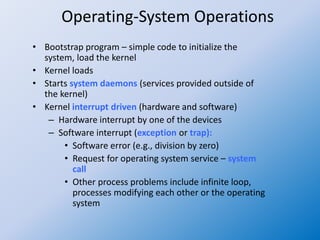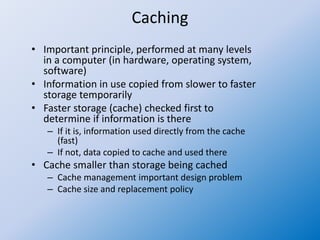Os concepts 4 functions of os
- 1. Operating System Concepts: 4 Functions of OS Prof Neeraj Bhargava Vaibhav Khanna Department of Computer Science School of Engineering and Systems Sciences Maharishi Dayanand Saraswati University Ajmer
- 2. Operating-System Operations • Bootstrap program – simple code to initialize the system, load the kernel • Kernel loads • Starts system daemons (services provided outside of the kernel) • Kernel interrupt driven (hardware and software) – Hardware interrupt by one of the devices – Software interrupt (exception or trap): • Software error (e.g., division by zero) • Request for operating system service – system call • Other process problems include infinite loop, processes modifying each other or the operating system
- 3. Multiprogramming and Multitasking • Multiprogramming (Batch system) needed for efficiency – Single user cannot keep CPU and I/O devices busy at all times – Multiprogramming organizes jobs (code and data) so CPU always has one to execute – A subset of total jobs in system is kept in memory – One job selected and run via job scheduling – When it has to wait (for I/O for example), OS switches to another job • Timesharing (multitasking) is logical extension in which CPU switches jobs so frequently that users can interact with each job while it is running, creating interactive computing – Response time should be < 1 second – Each user has at least one program executing in memory process – If several jobs ready to run at the same time CPU scheduling – If processes don’t fit in memory, swapping moves them in and out to run – Virtual memory allows execution of processes not completely in memory
- 4. Memory Layout for Multiprogrammed System
- 5. Dual-mode and Multimode Operation • Dual-mode operation allows OS to protect itself and other system components – User mode and kernel mode – Mode bit provided by hardware • Provides ability to distinguish when system is running user code or kernel code • Some instructions designated as privileged, only executable in kernel mode • System call changes mode to kernel, return from call resets it to user • Increasingly CPUs support multi-mode operations – i.e. virtual machine manager (VMM) mode for guest VMs
- 6. Transition from User to Kernel Mode • Timer to prevent infinite loop / process hogging resources – Timer is set to interrupt the computer after some time period – Keep a counter that is decremented by the physical clock – Operating system set the counter (privileged instruction) – When counter zero generate an interrupt – Set up before scheduling process to regain control or terminate program that exceeds allotted time
- 7. Process Management • A process is a program in execution. It is a unit of work within the system. Program is a passive entity, process is an active entity. • Process needs resources to accomplish its task – CPU, memory, I/O, files – Initialization data • Process termination requires reclaim of any reusable resources • Single-threaded process has one program counter specifying location of next instruction to execute – Process executes instructions sequentially, one at a time, until completion • Multi-threaded process has one program counter per thread • Typically system has many processes, some user, some operating system running concurrently on one or more CPUs – Concurrency by multiplexing the CPUs among the processes / threads
- 8. Process Management Activities • Creating and deleting both user and system processes • Suspending and resuming processes • Providing mechanisms for process synchronization • Providing mechanisms for process communication • Providing mechanisms for deadlock handling The operating system is responsible for the following activities in connection with process management:
- 9. Memory Management • To execute a program all (or part) of the instructions must be in memory • All (or part) of the data that is needed by the program must be in memory • Memory management determines what is in memory and when – Optimizing CPU utilization and computer response to users • Memory management activities – Keeping track of which parts of memory are currently being used and by whom – Deciding which processes (or parts thereof) and data to move into and out of memory – Allocating and deallocating memory space as needed
- 10. File-system Management • OS provides uniform, logical view of information storage – Abstracts physical properties to logical storage unit - file – Each medium is controlled by device (i.e., disk drive, tape drive) • Varying properties include access speed, capacity, data- transfer rate, access method (sequential or random) • File-System management – Files usually organized into directories – Access control on most systems to determine who can access what – OS activities include • Creating and deleting files and directories • Primitives to manipulate files and directories • Mapping files onto secondary storage • Backup files onto stable (non-volatile) storage media
- 11. Mass-Storage Management • Usually disks used to store data that does not fit in main memory or data that must be kept for a “long” period of time • Proper management is of central importance • Entire speed of computer operation hinges on disk subsystem and its algorithms • OS activities – Mounting and unmounting – Free-space management – Storage allocation – Disk scheduling – Partitioning – Protection • Some storage need not be fast – Tertiary storage includes optical storage, magnetic tape – Still must be managed – by OS or applications
- 12. Caching • Important principle, performed at many levels in a computer (in hardware, operating system, software) • Information in use copied from slower to faster storage temporarily • Faster storage (cache) checked first to determine if information is there – If it is, information used directly from the cache (fast) – If not, data copied to cache and used there • Cache smaller than storage being cached – Cache management important design problem – Cache size and replacement policy











